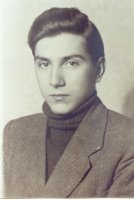
Jerzy Lisiecki,
born on August 22, 1923 in Warsaw
leading rifleman, The Home Army (AK) soldier a.k.a. "2422", "Jerzy II"
Battalion "Ruczaj", Company "Tadeusz Czarny", Platoon "Orlik"
Battalion "Harnaś", Company "Genowefa", Platoon 138
The Witnesses' Uprising Reports
Memoirs of Jerzy Lisiecki a.k.a. "2422", "Jerzy II", the soldier of two Uprising Battalions: "Ruczaj" and "Harnaś"
My life onwards
What happened next was capitulation. We all had a very rough time. As I had no information about my Mum and my brother, I decided not to let myself take captive. I took a decision: after leaving the City together with civilians, I'm going to look for my brother in evacuated hospitals. On October 3 or 4 together with my father, whom I had found in the meantime, and a couple of our friends, I left Warsaw. I didn't know what my friends had decided. Everyone would save themselves as it was possible. Some of them were taken captive. Standing in a long queue of people, being guarded by German soldiers, we left the City Centre to cross the Okęcie. I was wondering what to do. I had heard terrible things about Pruszków. Father had been seriously wounded and could hardly walk. He had a wound dressing applied to his leg and after a week it got improved. Father said he had friends in the Okęcie area. I told him, "Dad, I'll try to run awal, hopefully I will manage." I had an address to some parents' friends in Komorów. We had visited them during the occupation. They had a mansion there. I Said to my father, "If I succeed, we will meet there." I saw the Kraut turned his back, I opened a gate and burst into the first outbuilding of all. I heard behind me, "Halt, Halt!" ("Stop, stop!") but I simulated being deaf. I kept walking further on, paying attention to nothing. I turned behind the house and heard somebody following me. I saw an opened window in a basement. Tomatoes and lots of bread loaves were lying there. I ran towards the pile and started to fill my pockets with food. At the back I heard the sound of the German's shoes. He caught me, kicked me and yelled, "Du verfluchte, komm" ("Come here, you damned one"). I replied, "Ich bin hungrich" ("I'm hungry"). He drove me out of this basement. Luckily there were those tomatoes and loaves of bread, otherwise I don't know how it could end. It was an elderly German wearing an aviator uniform. I can describe him as a sad sack, a well built man of about 50 years old. He made me come back to the line of people. We moved again. I caught up with my father and our friends. Afterwards, we manager to leave that group of people we had created. Admittedly, every tens meters there stood a German soldier but one of them was bribed. We spent the night at our friends' in the Okęcie area, from which we got into Komorów. There was a need to survive somehow. For some time we used to stay with our friends in Komorów. As we had cousins (those who moved from the Poznań region) who were staying in Pruszków in the Owocowa street, which was about 2 kilometers away. So we moved to them and stayed there. Father was informed somehow about the agreement between the Germans and the Polish authorities that stated the following: whoever was an owner of any business in Warsaw, was allowed to evacuate its fittings. It was our chance to get to the Drewniana street and make sure what had happened to the hospital in which Konrad and Mum used to stay. Father had a proper certification of being an owner of the workshop in Nowy Świat 27. During the occupation he would come there from time to time, mainly to sell screws in the Zielna street. So father hired a wagon with its driver, a German Begleiter (an escort). It was November when we set forth Warsaw.
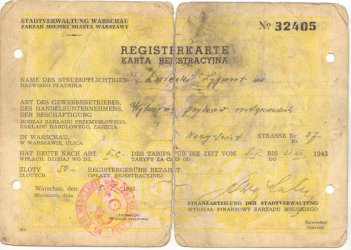 |
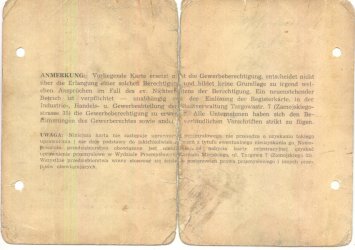 |
the permission for Piotr Lisiecki to run his workshop
We found ourselves in Nowy Świat. The house was completely burnt but the strongbox remained undamaged. Father used to have a part of the workshop in the basement whereas the other part was situated in the second backyard where the whole room was not damaged. There were some X-ray lamps there, the old-type ones, and father took them intentionally. We also loaded some other things onto the cart and started to wonder how to get to the Drewniana street.
Our cart could hardly pass through. Everywhere one could see rubble, a bit tidied up. We drove down along the Tamka street. Father had the information written on a pad that the hospital was situated at school in the Drewniana street. We reached the destination. There was nobody to be seen around. Begleiter and the cart driver went somewhere and we entered the school.
It was a big building, almost undamaged. Upstairs inside it was perfectly tidied up. I saw such neatness as if everything had been evacuated. No disorder, nothing like that. We went to the basement. There were huge windows looking out on the neighbouring street. Father said, "Go there and I will go to the adjacent basement."
I went down to the basement, looking around to he hospital could have been. I saw a big room that seemed to be entirely empty. The only thing I could notice was a single metal bed. Somebody was lying on the bed.
I came closer and saw the burnt body, bright chocolate-coloured. I bent forward and saw a little face. It must have been a pretty girl. The corpse was lying upright, arms alongside the body. The straw mattress must have burnt completely. On the one of burnt legs there was plaster.
I yelled to father, "Dad, come and see, there is nobody here". I took it for granted that the hospital had been evacuated and that place was the mortuary, with some young woman just lying. I didn't have a closer look at that dead person. Father came nearer but said nothing. I suppose he had understood everything then but he didn't share the truth with me at the time. There was neither Mum nor my brother there so I decided to come back to Pruszków.
Afterwards we moved to Częstochowa and took up residence in Aleja Najświętszej Marii Panny. There, on January 17, we experienced deliberation. A week later we decided to go to Warsaw. We hoped to go to the Drewniana street and meet someone who was aware of the hospital's lot. First trains started to get to Warsaw. One used to travel by a very crowded freight train. Exhausted, we reached Warsaw and stayed at father's friends in the Mokotowska street. And then we went to the Drewniana street.
The school was open. It was clean inside, lessons had probably begun or they were Just to Begin. We went to the school secretary's office. We were told there had been a hospital indeed during the Uprising and we could meet the caretakers who had been there at the time.
So we went to the room occupied by the caretakers. Having entered it, we found ourselves in a room in the middle of which some woman was lying in the bed. It was - as it turned out later - a caretaker's wife. We introduced ourselves and asked if Nadzieja Lisiecka with Her son had once stayed there. The woman replied she didn't know anything and asked us to come in few hours to talk to Her husband.
Few hours passed and, as agreed, we came back. The caretaker was present and said he remembered Mrs. Nadzieja and her son very well. And he started to cry. He told us that on September 27, 1944 SS-men from the Dirlewanger's group had rushed in to the hospital that had stayed on no one's land for over 2 weeks. They forced out the doctor and nurses and all the wounded staying in the basement were shot by them. My Mum didn't want to leave Konrad so she was also shot. Then, they Pored petrol on the corpses and set on fire. More than twenty people were killed there altogether.
The man said that the corpse I had mistaken for a young girl was my brother's and Mum was lying underneath. All the casualties were then buried in a huge hole dug in front of the school. I entirely fell into pieces. Father was tough-minded and cool-headed. The caretaker asked us to give him our address and promised to let us know about the date of exhumation.
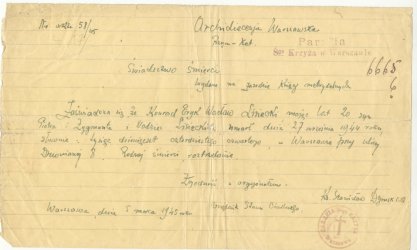 |
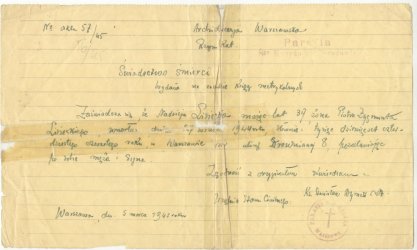 |
death certificates of both my brother and my mother in rough versions
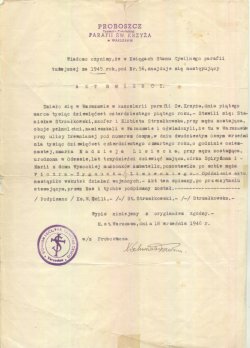
the official death certificate of Nadzieja Lisiecka
We came back to Częstochowa. After 2-3 weeks in the streets I saw posters saying, "AK zapluty karzeł reakcji" (invectives against the Home Army). I started to wonder what should be done by me. Father had been telling us about the Soviets. He had come back to Poland from Russia not earlier than in the year 1923. I also was aware of what had happened in Katyń and whose work it had been. I knew it had been done by NKWD (Narodnyj Komissariat Wnutriennich Dieł). I was afraid they would take me to the army as I was 21 then. There was not something I would do gladly.
I had not registered my residence in Częstochowa yet. All I had was my Arbeitskarte with my date of birth - the year 1923 had been written by means of an ink pen. I decided to make myself younger. So I changed a number 3 to a number 8. And I became 5 years younger. I registered myself on the grounds of that document. This date is in all my documents, including my ID, till now. I don't think I will change that.
As it had been promised, the caretaker from the Drewniana street let us know about the date of exhumation. I took place in May 1945. I went there alone, father didn't want to go. A dozen or so people participated. The date was not proper. It was hot and swarms of flies were flying over the hole.
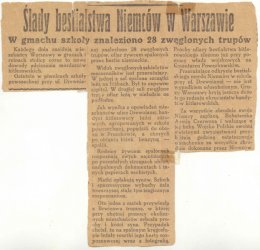 |
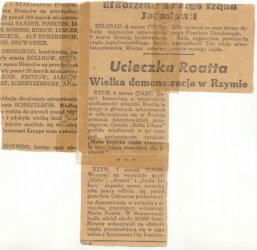 |
the newspaper dated on March 1945 with the information of the murder at the school in the Drewniana street
The corpses were much decomposed. At one point a skull with an opening in the middle of the body, the one made by a bullet. There was almost no flesh left but jet-black hair with a grey curl had remained. One of the teeth at the front of the jaw had a bit different colour of a filling. There was my Mum's skull. Her hair was very distinctive. Before the war Mum had complained much about her dentist who had chosen the filling's colour wrongly. Mum had very beautiful teeth. My brother's leg put in plaster was also taken out. At the moment of death my Mum was 39 whereas my brother was 19.
Apart from me the wives of two senior Home Army officers of the "Radosław" group, i.e. lieutenant-colonel Wacław Janaszek a.k.a. "Bolek" and major Mieczysław Kurkowski a.k.a. "Sawa", took part in the exhumation. Both, having been wounded in the Old Town, were then transported through sewers to the Warecka street in the City Centre, from where they were next transported, nobody knows why, to the hospital in the Drewniana street. There they were killed, like my Mum and my brother. Another two persons were recognized. It was Maria Grabusińska - aged 60 and her daughter Irena - aged 31. Mr. Grabusiński recognised them.
Lieutenant-colonel Wacław Janaszek and major Mieczysław Kurkowski were found lying side by side, as if in a firm grasp. Their wives decided they were to be buried together. I made a decision together with Mr. Grabusiński that the remaining killed ones Gould be buried in a mutual grave. The corpses were put into 3 big wooded chests made of not planed planks that were next put on the carts. Then the funeral procession set off along Wybrzeże Kościuszkowskie towards the Military Cemetery. I don't remember if there was a priest in the procession. I was accompanied by my girlfriend and her mother.
At the cemetery there was a dug hole in which they all were buried together. Father, I and Mr. Grabusiński put a mutual grave. Apart from four people whose names are written on two plaques there are c. 15 unidentified corpses there as well. The tomb is situated behind the "Zośka" quarter, next to the grave of the poet Krzysztof Kamil Baczyński.
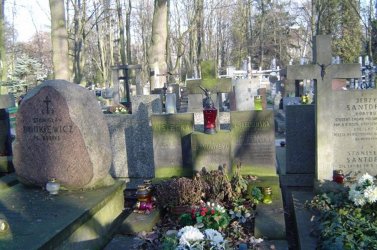
a collective tomb at the Military Cemetery
Lieutenant-colonel Wacław Janaszek and major Mieczysław Kurkowski were buried at the "Miotła" quarter.
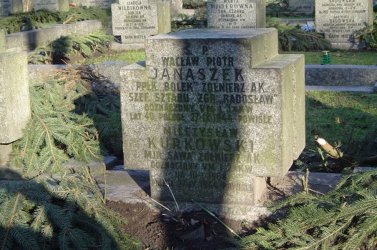
the tomb of Lieutenant-colonel Wacław Janaszek and major Mieczysław Kurkowski
In the year 1965 a commemorative plaque was situated on the wall of the school building in the Drewniana 8 street, the one dedicated to the murder in the Uprising hospital.
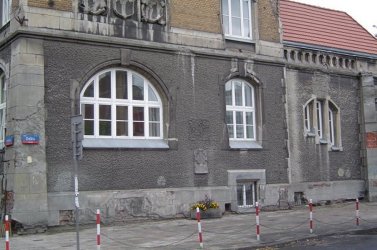 |
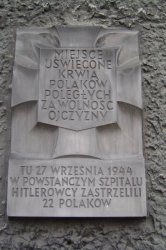 |
a commemorative plaque on the wall of the school building in the Drewniana 8 street
Till now I have been bothered by the mysterious tragedy of the hospital in the Drewniana street. The hospital was well-known at the river-bank of the Vistula district. It was apparently so well supplied that neighbouring uprising hospital used to be provided with food there. On September 27, 1944, on the day of the execution in the Drewniana street, the nuns from the Tamka hospital had managed to make the wounded evacuate, and the latter were transported away on 7 carts. It happened in the distance of 300 meters away from the Drewniana hospital. Why the wounded from that hospital were not taken as well? Apparently, the hospital chief played a part in this as he didn't want the evacuation. Besides, I have no idea at all why my brother had been taken from the City Centre to the hospital at the river-bank of the Vistula district not more than few day before this district was captured by Germans. The doctor who had been the hospital chief and survived, was not present during the exhumation. So I could not require any explanation from him. There are no hospital records illustrating its last days. The latest entries concern the date of August 28, 1944.
The war was over and one had to keep on living. I made a decision of undertaking studies. In order to do so I needed a document of having passed my Matura exam. As I mentioned before, I had done that in June 1944.
The Górski secondary school building was totally damaged. On the ruins I founmd a note stating that the school was situated in the Nowogrodzka street. I went there and met friends who told me that the school was in the Smolna street then, in the Zamoyski secondary school building.
There I met my former teachers, many of whom had survived the occupation and the Uprising. We greeted heartily. I told my tutor that I needed my Matura certificate. He replied there was no difficulty, I was to get it soon. I told him, yet, there could be some problem and explained the fact of my having changed the date of birth.
Professor kept wondering deeply and Said it was a problem indeed. If he wrote I had been born in the year 1928, it would mean I passed my Matura exam at the age of less than 16, which was nonsense. The secret police would undoubtedly get interested in that. On reflection he told me, "Jerzy, we can issue the certificate for you with a birth date of the year 1927. It might work."
And so it happened. I became the 1927 high school graduate. An office worker of the department of education congratulated me having taken me for the youngest high school graduate in the Warsaw region, simply a young genius.
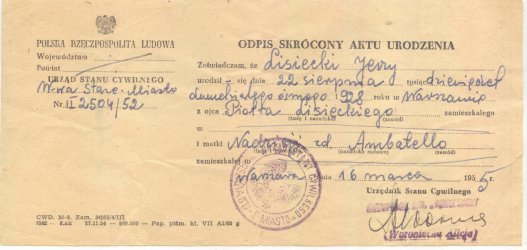
the birth certificate of Jerzy Lisiecki including a false date of birth
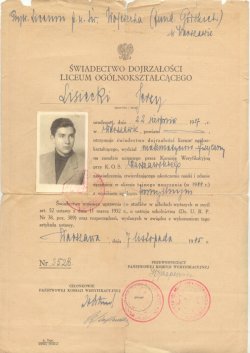
the school-leaving examination certificate of Jerzy Lisiecki
Father wished me to follow his example, to study at the university of technology. In the year 1946 I began the first year of studies in the Electric department of the Warsaw University of Technology. I was there taught by, among the others, Prof. Groszkowski, my father's friend, prof. Kocjan and other famous Polish scholars.
I took up residence in Anin, the same place where the whole my family used to live before the war. I met a lot of friends there. The great help in our maintenance were parcels from the Young Men's Christian Association that we used to receive for some time. Later they were done away with. To get to the university I would travel by electric train. Study was quite taught for me. I started to skip classes. I got depressed because of such tragic loss of my closed ones. My frustration was intensified by the fact that father got married for the second time. For a long time I was not able to forgive him that.
As a consequence, I didn't manage to complete even the first year of studies. Father was very disappointed. It was about Prof. Groszkowski. The second father's wife helped me. She had a large family and lots of contacts in Poznań. Persuaded by her I went to Poznań and undertook studies at the Trade Academy in Poznań. I found accommodation in the house of her relatives.
The change truly helped me to recover mentally. In the university secretary's office my school-leaving university certificate not compliant with the date of birth was somehow accepted. They could have guessed the truth but in those times miracles were not unusual.
I successfully graduated from the studies. The subject of my diploma thesis was, "Well-balanced malting of brewing barley". My two-month-practice was undergone by me in the Tychy brewery, since when I have had a feeling for a beer brand Tyskie.
Afterwards I got a job warrant and started work in the Gdańsk Corn Plant. It was another change of my place of residence. During my canoeing holiday in the Mazuria Lake district, in Giżycko I met my future wife. We have been happily married for over 50 years. Recently we have celebrated our 50th wedding anniversary. After 4 years of stay in Gdańsk I came back to Warsaw for good.
Two years ago I took my son for holiday in Greece, to the Kefalonia island. I hoped to find some trace of my mother's family. My son found a Greek called Spirydon Apatello, like my grandfather. He was a photographer. Unfortunately he didn't recall anything about anyone of his family stay in Odessa at the beginning of the 20th century.
The sixth volume of the Great Encyclopedia of the Warsaw Uprising contains the information about both my brother and me.
Jerzy Lisiecki
edited by: Maciej Janaszek-Seydlitz
translated by: Monika Ałasa
Copyright © 2016 Maciej Janaszek-Seydlitz. All rights reserved.